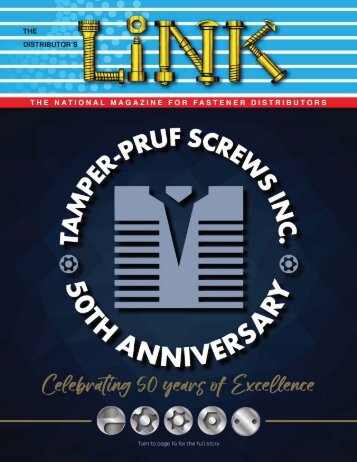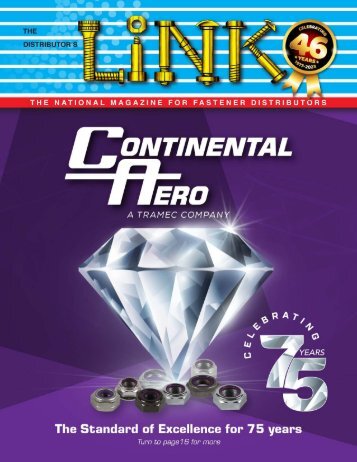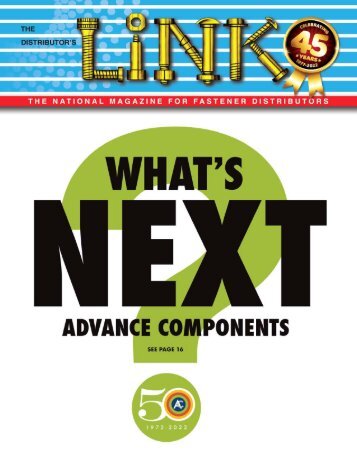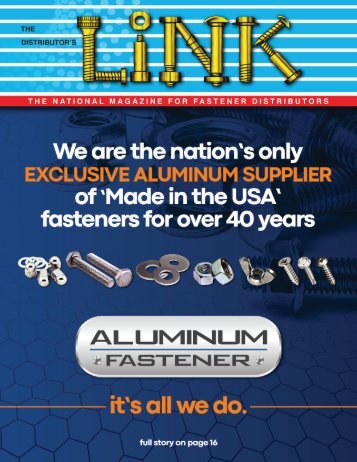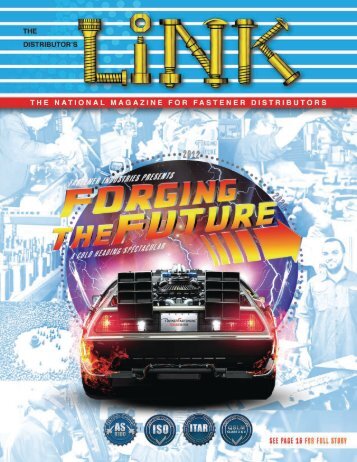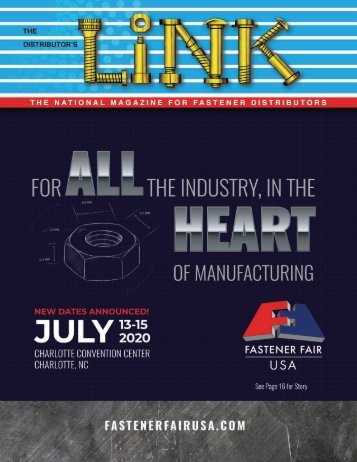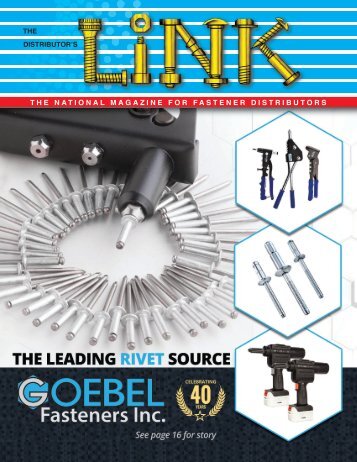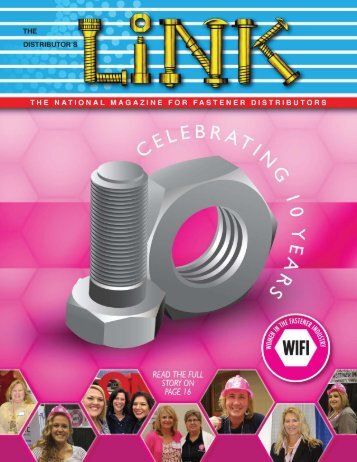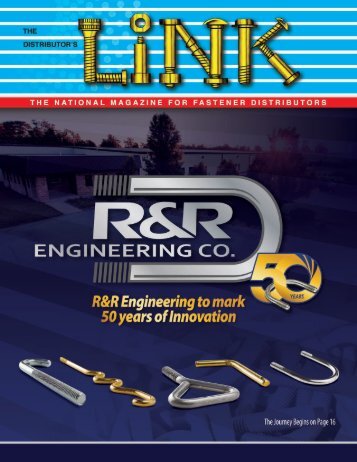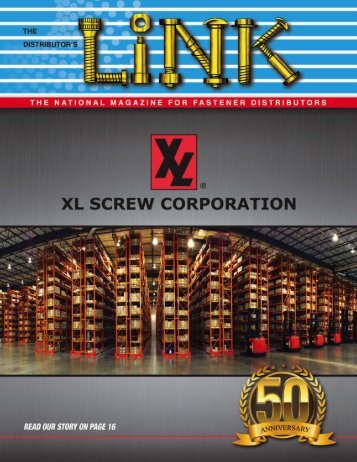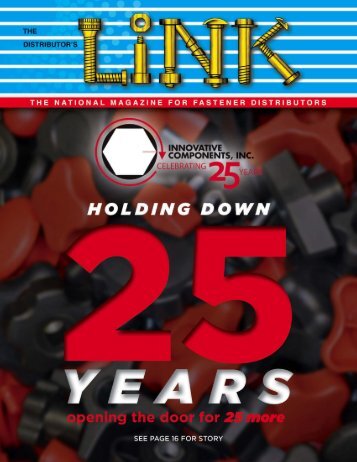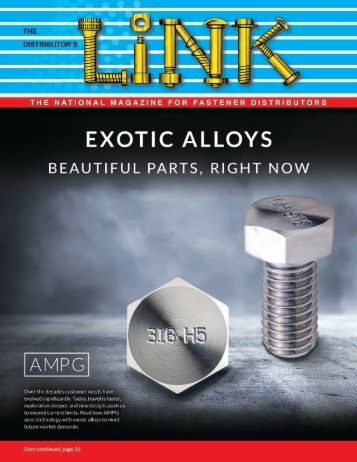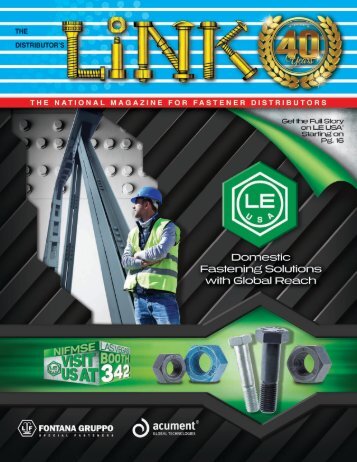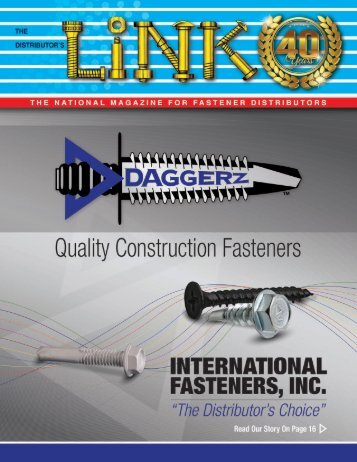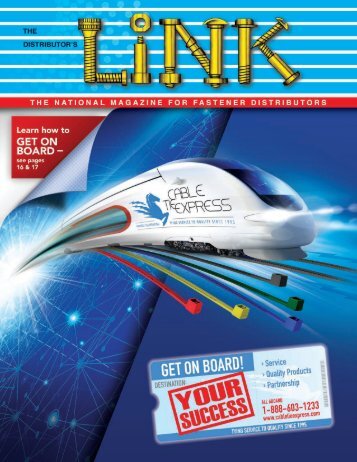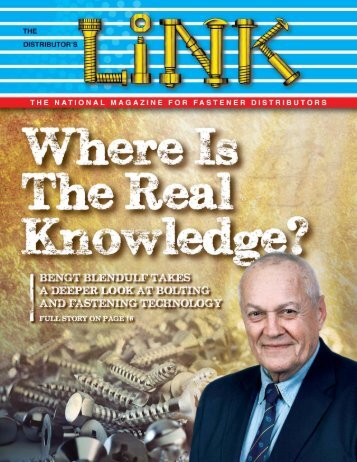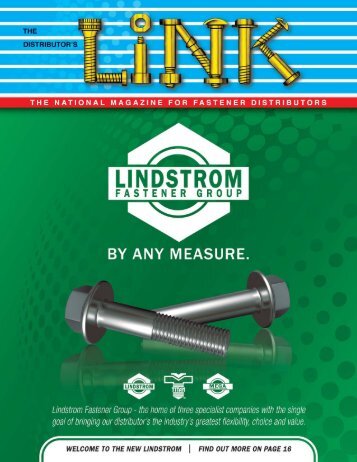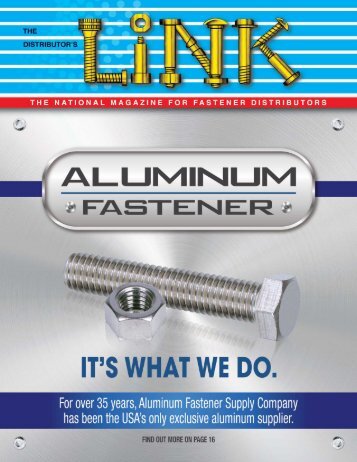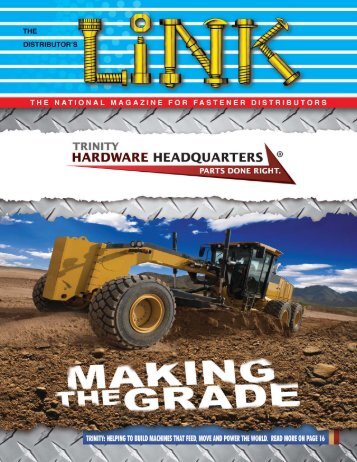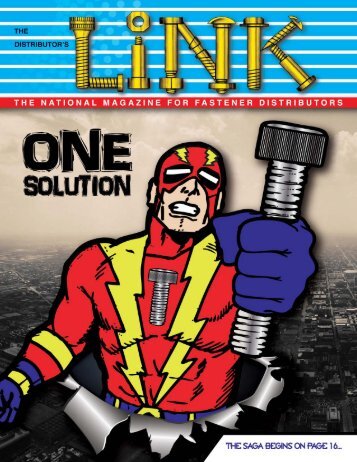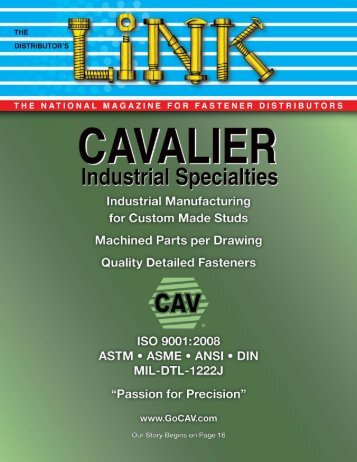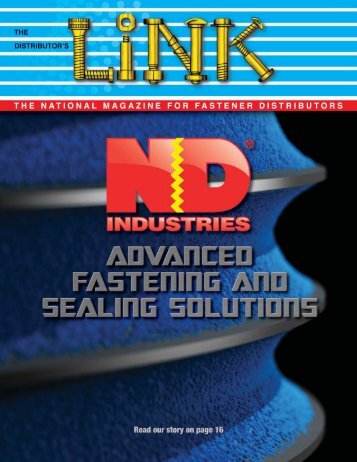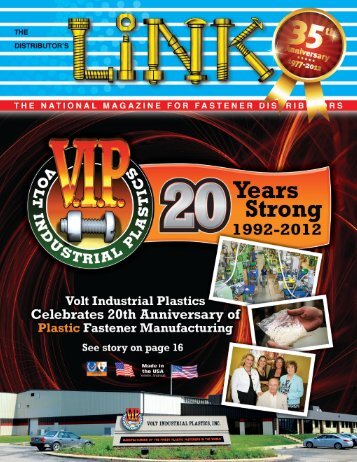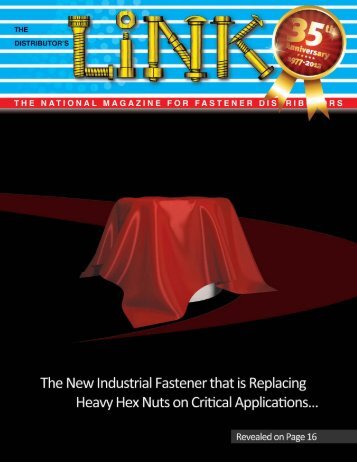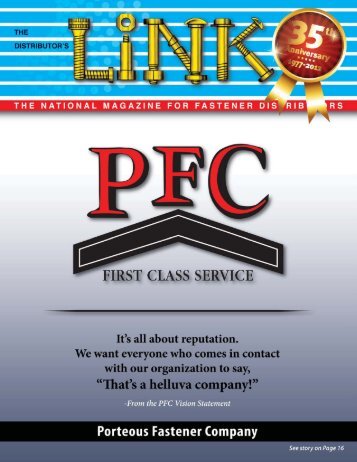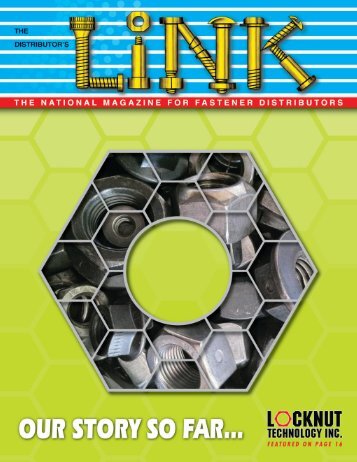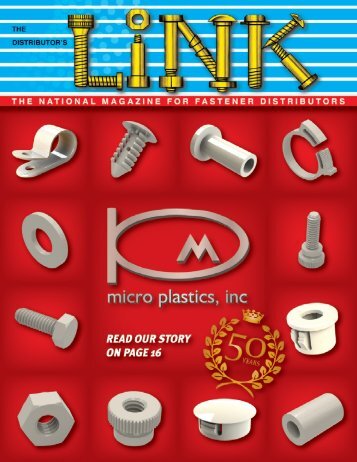FALL 2019
- Text
- Association
- Bolts
- Engineering
- Distributors
- Screws
- Manufacturing
- Products
- Industrial
- Fasteners
- Fastener
68 THE DISTRIBUTOR’S
68 THE DISTRIBUTOR’S LINK Anthony Di Maio Anthony E. Di Maio attended Wentworth Institute and Northeastern University. In 1962 he started working with Blind Fasteners as Vice-President of Engineering & Manufacturing for two blind rivet manufacturers. He has been Chairman of the Technical Committee of the Industrial Fasteners Institute (IFI) and is still involved in the writing of IFI specifications. In 1991, he started ADM Engineering and is working with Fastener Manufacturers developing new fasteners and special machinery. He can be reached at ADM Engineering, 6 Hermon Ave., Haverhill, MA 01832; phone and fax 978-521-0277; e-mail: tdimaio@verizon.net. PROPER HOLE CONDITIONS FOR BLIND RIVETING Work piece hole conditions can affect the performance of a blind rivet. Many times a blind rivet user will contact me that they are having a problem with their blind rivets setting properly. In many cases, it is not the blind that is causing their problem, but instead it is the condition of the hole in their work piece that is causing the problem. The following are some of the hole conditions that will give a blind rivet user a problem. Hole Burrs This condition occurs when drilling a hole with a dull drill and pushing the drill through the work piece rather than having the drill cut the material. A sharp drill should always be used when drill a hole for a blind rivet. A dull drill will cause a circular burr to be formed around the diameter of the hole. This condition can be created in a work piece made of any type of metal. A worn or dull hole punch will also leave a burr around the diameter of the hole to be riveted. In most cases, the burr is on the blind rivet upset side of the work piece because the drilling operation is usually performed from the operator side. Burr Break Away Upset Side tensile strength, the burr cuts into the blind rivet barrel upset. If the blind rivet body is made of aluminum and the work piece is made of steel, stainless steel or hard aluminum, the burr will cut away a portion or the entire barrel upset created by the mandrel head when setting the blind rivet. When a part of, or the entire upset is cut away when setting the blind rivet, this greatly reduces the tensile strength of the set blind rivet. To achieve the tensile strength of the set blind rivet, there must be no burr on the hole either on the upset side or the flange side of the work piece. The upset side burr will cut the blind rivet barrel upset and on the flange side it will cut the flange of the set blind rivet. Hole Diameter The diameter of the hole to be riveted is also important relative to the tensile strength and clamp load of the set blind rivet. All blind rivet manufacturers list the recommended minimum and maximum hole diameters for all sizes of blind rivets they produce. The minimum is not the problem. If the hole diameter is too small the body of the blind rivet will not entire the hole. The oversized hole is the problem for more than one reason. Flange Side FIGURE 1 FIGURE 2 When the blind rivet is inserted into the hole of the work piece and set, the mandrel head upsets the barrel of the blind rivet body and forms the barrel against the burr. As the mandrel is being pulled to it’s maximum CONTRIBUTOR ARTICLE When a blind rivet is set in an oversized hole, the mandrel head will pass through the barrel of the blind rivet body. The mandrel will continue down the blind rivet body until it teaches the flange of the blind rivet body. CONTINUED ON PAGE 146
- Page 6 and 7:
in the Fall 2019 issue of 6 DISTRIB
- Page 8:
6 THE DISTRIBUTOR’S LINK Earnest
- Page 12:
10 THE DISTRIBUTOR’S LINK GRABBIN
- Page 16:
14 THE DISTRIBUTOR’S LINK SPECIAL
- Page 19 and 20:
was to help people run their compan
- Page 22: THE ECONOMY No matter if you are bu
- Page 26: 24 THE DISTRIBUTOR’S LINK 1SHOT S
- Page 30: 28 THE DISTRIBUTOR’S LINK Rob LaP
- Page 34: 32 THE DISTRIBUTOR’S LINK NUTS, B
- Page 40 and 41: 36 THE DISTRIBUTOR’S LINK INDUSTR
- Page 42: 38 THE DISTRIBUTOR’S LINK Salim B
- Page 46: 42 THE DISTRIBUTOR’S LINK EFC Int
- Page 49 and 50: 3Q INC. CONTINUING TRADITIONS AT 3Q
- Page 51 and 52: OFFSHORE MILLING SERVICES INC. THE
- Page 54: 50 THE DISTRIBUTOR’S LINK Nelson
- Page 58 and 59: 54 THE DISTRIBUTOR’S LINK GLOBALF
- Page 60 and 61: 56 THE DISTRIBUTOR’S LINK PRIME I
- Page 62 and 63: 58 THE DISTRIBUTOR’S LINK WOMEN I
- Page 64: 60 THE DISTRIBUTOR’S LINK A PEER
- Page 67 and 68: THE DISTRIBUTOR’S LINK 63
- Page 70 and 71: 66 THE DISTRIBUTOR’S LINK MID-WES
- Page 74: 70 THE DISTRIBUTOR’S LINK The Met
- Page 77 and 78: THE DISTRIBUTOR’S LINK 73 INTEGRA
- Page 79 and 80: THE DISTRIBUTOR’S LINK 75 The Ola
- Page 81 and 82: THE DISTRIBUTOR’S LINK 77
- Page 84 and 85: 80 THE DISTRIBUTOR’S LINK INTERNA
- Page 86 and 87: 82 THE DISTRIBUTOR’S LINK VOLT IN
- Page 88: 84 THE DISTRIBUTOR’S LINK NATIONA
- Page 91 and 92: BRIGHTON-BEST INTERNATIONAL COCKTAI
- Page 93 and 94: INTERNATIONAL FASTENERS, INC. NEW W
- Page 95 and 96: NEFDA 31st ANNUAL GOLF OUTING OAK R
- Page 97 and 98: THE DISTRIBUTOR’S LINK 93
- Page 100 and 101: 96 THE DISTRIBUTOR’S LINK INTERCO
- Page 102 and 103: INTERNATIONAL FASTENER EXPO MANDALA
- Page 104: 100 THE DISTRIBUTOR’S LINK LAUREN
- Page 107 and 108: THE DISTRIBUTOR’S LINK 103
- Page 109 and 110: THE DISTRIBUTOR’S LINK 105 1Shot
- Page 112 and 113: 108 THE DISTRIBUTOR’S LINK FASTEN
- Page 114 and 115: 110 THE DISTRIBUTOR’S LINK ROB La
- Page 116 and 117: 112 THE DISTRIBUTOR’S LINK JO MOR
- Page 118 and 119: 114 THE DISTRIBUTOR’S LINK NUTS,
- Page 120: 116 THE DISTRIBUTOR’S LINK JOE DY
- Page 123 and 124:
THE DISTRIBUTOR’S LINK 119 SALIM
- Page 126 and 127:
122 THE DISTRIBUTOR’S LINK LARRY
- Page 128 and 129:
124 THE DISTRIBUTOR’S LINK FASTEN
- Page 130:
126 THE DISTRIBUTOR’S LINK JIM TR
- Page 133 and 134:
THE DISTRIBUTOR’S LINK 129 NCFA 2
- Page 135 and 136:
The Agrati Group, a global manufact
- Page 138 and 139:
fastenerlinks THE DEFINITIVE WEB DI
- Page 140 and 141:
fastenerlinks BRINGING YOU THE FAST
- Page 142:
fastenerlinks BRINGING YOU THE FAST
- Page 145 and 146:
THE DISTRIBUTOR’S LINK 141
- Page 147 and 148:
INTERNATIONAL FASTENER EXPO WELCOME
- Page 150 and 151:
146 THE DISTRIBUTOR’S LINK ANTHON
- Page 152 and 153:
148 THE DISTRIBUTOR’S LINK SPIROL
- Page 154 and 155:
150 THE DISTRIBUTOR’S LINK ABBOTT
- Page 156:
152 THE DISTRIBUTOR’S LINK IFE IF
- Page 159 and 160:
INTERNATIONAL FASTENER EXPO MANDALA
- Page 162 and 163:
158 THE DISTRIBUTOR’S LINK LAUREN
- Page 164 and 165:
160 THE DISTRIBUTOR’S LINK RYAN B
- Page 166 and 167:
162 THE DISTRIBUTOR’S LINK ROB La
- Page 168 and 169:
164 THE DISTRIBUTOR’S LINK JOE DY
- Page 170:
166 THE DISTRIBUTOR’S LINK ROBERT
- Page 173 and 174:
Innovative Components Inc. is proud
- Page 176 and 177:
172 THE DISTRIBUTOR’S LINK RYAN B
- Page 178 and 179:
174 THE DISTRIBUTOR’S LINK FASTEN
- Page 180 and 181:
176 THE DISTRIBUTOR’S LINK SOUTHW
- Page 182 and 183:
178 THE DISTRIBUTOR’S LINK RYAN B
- Page 184 and 185:
180 THE DISTRIBUTOR’S LINK FASTEN
- Page 186 and 187:
182 THE DISTRIBUTOR’S LINK WOMEN
- Page 188 and 189:
184 THE DISTRIBUTOR’S LINK INTERN
- Page 190 and 191:
INTERNATIONAL FASTENER EXPO MANDALA
- Page 192 and 193:
INTERNATIONAL FASTENER EXPO MANDALA
- Page 194:
INTERNATIONAL FASTENER EXPO MANDALA
- Page 198:
advertisers index # 3Q, INC. 45 Fla
- Page 202:
advertisers index I INDUSTRIAL RIVE
Inappropriate
Loading...
Mail this publication
Loading...
Embed
Loading...
|
SHARE A PAGE FROM THIS MAGAZINE OPTION 1: Click on the share tab above, or OPTION 2: Click on the icon (far right of toolbar) and then click on the icon (far right of toolbar) and then click on the  icon (top right of the page). icon (top right of the page).
|
View Archives
Copyright © Distributor's Link, Inc. All Rights Reserved | Privacy Policy







